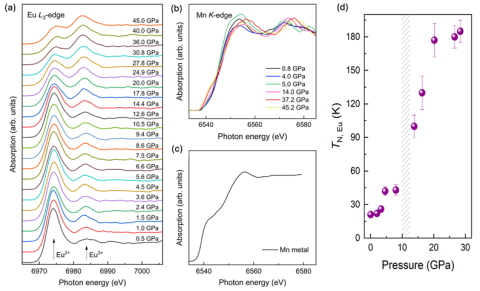Continuous pressure-induced valence and magnetic transitions in EuMnSb2
EuMnSb2 is a unique Dirac candidate compound with dual magnetic orders and a sizable coupling between the magnetic Mn and Eu sublattices. Earlier studies, through the application of an external magnetic field, have shown that the strongly coupled Eu magnetism and charge transport enable the magnetic control of topological quasiparticles. Motivated by this strong tunability, researchers led by Wenli Bi’s group at the University of Alabama at Birmingham applied external pressure to EuMnSb2 and systematically investigated the magnetic state, valence states of both Eu and Mn sublattices, and the crystal structure using time-domain synchrotron Mössbauer spectroscopy in 151Eu, X-ray absorption spectroscopy (XAS) at Eu L3 edge and Mn K-edge, and synchrotron X-ray diffraction. They found that the magnetic ordering temperature of Eu sublattice increases monotonically under compression, from 21 K at ambient pressure to 180 K at 28.4 GPa, despite the decreasing magnetic moment due to a large valence transition from Eu2+ toward Eu3+. In this pressure range, the orthorhombic crystal structure remains stable. Additionally, high-pressure X-ray absorption studies at the Mn K-edge show that the divalent Mn state remains stable up to 45 GPa, while an increasing pre-edge feature indicates 3d delocalization of Mn through 3d-4p orbital mixing. The combined evidence points to the possibility of hybridization of Eu 5d with Mn 3d orbitals. This orbital hybridization likely contributes to the further enhanced exchange interaction, in addition to the strengthened interaction from the reduced distance between neighboring Eu ions. These findings mark EuMnSb2 as a rich platform for investigating strongly correlated physics.
This study is recently published in the Physical Review B as an Editors’ Suggestion. More details of this study can be found in the following publication:
R. Sereika, G. C. Jose, S. Huang, R. Jin, W. A. Shelton, W. Xie, J. Zhao, B. Lavina, E. E. Alp, Y. Xiao, D. Zhang, Y. K. Vohra, W. Bi, Continuous pressure-induced valence and magnetic transitions in EuMnSb2. Phys. Rev. B. 110, 1–8 (2024). https://doi.org/10.1103/PhysRevB.110.075127

